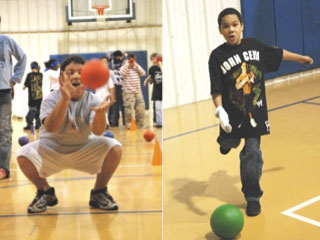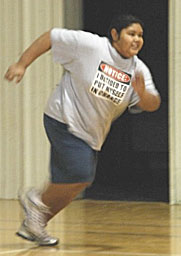 |
Canku Ota
|
 |
|
(Many Paths)
|
||
|
An Online Newsletter
Celebrating Native America
|
||
|
August 1, 2009 - Volume
7 Number 8
|
||
|
|
||
|
Move It! Kits Meant
To Motivate Educators And Parents
|
||
|
by S.E. Ruckman, Indian
Country Today correspondent
|
||
|
Dr. Charlene Avery hopes that a mid-July push of Move It! kits will prompt parents and educators of Native kids to be active against the onset of the disease. Avery, an Indian physician in Albuquerque, sees the numbers of Indian children who will likely develop it rising steadily. Avery maintains the tide does not have to take Indian youth down the same path as their elders. Data rates for diabetes are alarming. The rate for new cases nearly doubled in the last 10 years, according to the Centers for Disease Control and Prevention. American Medical Journal researchers found that of all Indian children with diabetes, some 86.2 percent have Type 2, compared to 59.7 percent among Asian and Pacific Islander children. The numbers mean that breaking the cycle will come by weight loss and increased physical activity for people at risk. One of the biggest culprits for child Type 2 diabetes susceptibility is not found outside the home, but inside, officials said.
"Some effective strategies to achieve increased activity and decrease the likelihood of obesity include removing televisions from bedrooms and reducing the amount of time spent watching TV and playing video games." Despite the climate of visual overstimulation, proper nutrition and good old-fashioned activity lends to an inactive generation that still face all the social hurdles of being Native. "The socioeconomic conditions in many areas of Indian country have given rise to depression, poor education, high unemployment rates, domestic violence, substance abuse, poor self-esteem," Avery said. The physician said additional factors of everyday life in Indian country complicate the picture. These include lack of access to needed services and a high suicide rate among Native youth adding to stress which produces anxiety. The end result is hopelessness. "Parents, tribal leaders, students and tribal citizens must involve themselves at all levels to reverse these conditions. Preservation of tribal identity and cultural practices are likely the most significant factors in the survival of tribal people as a whole." Avery said obese children may have Acanthosis nigricans and are especially at risk. The darkening of skin behind the neck that sometimes extends to the front can be a sign of insulin resistance, a cardinal feature of Type 2 diabetes. The good news is that with exercise and weight loss, it can be reversed. Knowing and watching for this sign can also help motivate caregivers to prod children to eat healthier and get more exercise, she said. Coupled with the medical approach, communities can be vigilant. A mail-out of Move It! kits to more than 1,200 partners of the National Diabetes Education Program will begin July 15. The kits are directed to communities or groups that deal primarily with Indian children, specifically youth ages 12 and up. Some Move It! kit destinations include: Davenport Public Schools in Oklahoma; Hannahville Public Schools in Michigan and Pine Point in North Dakota, said Noelle Kleszynski, diabetes program director at the Association of American Indian Physicians. She said Move It! kits stress a community-based awareness campaign that isn't too difficult, even for the smallest communities. "The great thing about the kits is that they are designed to motivate a community while keeping the focus on youth in Indian country." The diabetes prevention kits include fact sheets, a CD, pedometer order forms and a how-to approach for their schools' administration to promote diabetes awareness for Indian children. Additionally, the kits have culturally specific books on health and diabetes prevention and posters that utilize Indian sensibilities regarding health and elders. Communities who see potential for the Move It! prevention kits can find a template included for writing press releases to announce local events. |
|
|
||
|
|
||
| Canku Ota is a free Newsletter celebrating Native America, its traditions and accomplishments . We do not provide subscriber or visitor names to anyone. Some articles presented in Canku Ota may contain copyright material. We have received appropriate permissions for republishing any articles. Material appearing here is distributed without profit or monetary gain to those who have expressed an interest. This is in accordance with Title 17 U.S.C. Section 107. | ||
|
Canku Ota is a copyright ©
2000, 2001, 2002, 2003, 2004, 2005, 2006, 2007, 2008, 2009 of Vicki
Barry and Paul Barry.
|
||
 |
 |
|
|
The "Canku
Ota - A Newsletter Celebrating Native America" web site and
its design is the
|
||
|
Copyright ©
1999, 2000, 2001, 2002, 2003, 2004, 2005,
2006, 2007, 2008, 2009 of Paul
C. Barry.
|
||
|
All Rights Reserved.
|
||
 ALBUQUERQUE,
N.M. – With little exercise and poor eating habits, American
Indian children are one of the groups most vulnerable to Type 2
diabetes.
ALBUQUERQUE,
N.M. – With little exercise and poor eating habits, American
Indian children are one of the groups most vulnerable to Type 2
diabetes. Television
and video games are luring Indian children to sit and remain inactive
rather than allowing their metabolism to work to its fullest. Avery
is dismayed, but determined.
Television
and video games are luring Indian children to sit and remain inactive
rather than allowing their metabolism to work to its fullest. Avery
is dismayed, but determined.